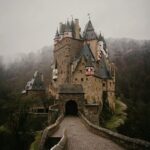 Castle Braunfels is located on a basalt rock west of the health resort Braunfels in the Central Hessian Lahn-Dill-Kreis. The castle soars 100 m (328 ft) above the Lahn valley. It has been the seat of the Counts of Solms since the 13th century and is still owned by the counts of Oppersdorff and Solms-Braunfels in the 21st century.
Castle Braunfels is located on a basalt rock west of the health resort Braunfels in the Central Hessian Lahn-Dill-Kreis. The castle soars 100 m (328 ft) above the Lahn valley. It has been the seat of the Counts of Solms since the 13th century and is still owned by the counts of Oppersdorff and Solms-Braunfels in the 21st century.
As Castellum Bruninvels, the castle was first documented in 1246. Originally a defensive stronghold against the counts of Nassau, it became the residence of the Counts of Solms in 1280.
The palace’s appearance has changed much over the years, with new additions to the complex as well as the destruction of other parts. In 1679, much of Braunfels was incinerated in a terrible fire. Count Heinrich Trajektin was responsible for the reconstruction.
In 1845, Braunfels Castle underwent a renovation at the hands of the “Hunter Prince” Ferdinand who rebuilt parts of it in the Gothic Revival style and added its famous Knights Hall.

View from the west with Kleppertor
The castle got yet another makeover just 35 years later by Prince George. He is the man to thank for the castle’s present look. Much of its unique features, like the towers and bay windows, can be attributed to him.
The interiors are designed as a museum and partially accessible with a guide. The princely representative rooms, the collections from Altenberg Abbey and the Family Museum must be distinguished.
The furniture and the art-historical collections of the Princely Family of Solms cover the time period from the 13th to the 19th century.
- Restored in the 19th century, the Knights’ Hall in the medieval Palas contains weapons for striking, stabbing and firing, as well as armor for warriors and horses from the Middle Ages to the Baroque period. The oldest items are a gothic sword and a chainmail from the time of the Crusades, consisting of 60,000 small rings (blacksmith time 1-2 years). Maximilian armor presumably comes from Milan.
- In the staircase and in the picture gallery hang oil paintings – especially family portraits, mythological and allegorical scenes – from the schools of Italian, Spanish, Dutch and German masters from the Renaissance to Classicism. In the center of the staircase room is the bust of the 99-day Emperor Friedrich III.
- The tapestry room is characterized by five Flemish tapestries around 1600, depicting hunting and pastoral scenes. The stove comes from 1674 from the Aßlarer hut.
- The historical highlight is the Flemish room with portraits, seascapes and genre scenes by Adriaen van de Velde, Jan Miense Molenaer and Adriaen van Ostade. Also here is a stove from Aßlar.
- The Tischbeinzimmer is named after the painter family, who worked in several generations in the 18th century on behalf of the Counts of Solms.
- Other portraits, hunting pieces and genre paintings include the Deiker Gallery (court painter to Prince Ferdinand 1843-1868), the Blue Salon and the Rosa Salon. The family’s antiques in the showrooms include vases of East Asian provenance, St. Petersburg and the Berlin porcelain manufactory. Also, a small glass collection is exhibited in a display case, including Venetian thread glasses and Romans.
The so-called “Altenberger rooms” include inventory from the former monastery Altenberg. In its secularization with the Reichsdeputationshauptschluss 1803, the princes of Solms took over the institution.
- The Gothic room contains a late Gothic altar and a Rhenish Madonna (around 1400). From Gertrud von Altenberg comes a chest in which allegedly objects of her mother Elisabeth of Thuringia were kept. When Elisabeth after the death of her husband, the landgrave Ludwig IV (Thuringia), the Wartburg had to leave in 1227 and 1229 under the aegis of Konrad von Marburg nurse in one of her endowed Franciscan hospital, she had her then 4-year-old daughter Gertrud at the instigation of her confessor to education in the monastery Altenberg.
- Even more alleged memorabilia of Saint Elizabeth, proven to date from the 13th century, are kept in the adjoining Paramentenzimmer. Whether the silver jug from which Elisabeth gave the wine to the sick, and the ring, a gift from the landgrave, with the large oval stone which is said to have shattered at the moment of his death, is no longer detectable. Tourism at Schloss Braunfels lives from this history or legend.
- As a work of an unknown master is the Altenberg altar from around 1330, a winged altar with Gothic tracery. On this altar the sculpture of a Madonna and Child from the second half of the 14th century was originally erected.
The Family Museum in the Long Building (individually accessible by coin slot) contains other weapons and art collections, coins, medals, garments and a collection of Bohemian glass of the Dukes of Solms. There is also a prehistoric department, which is due to a collaboration between Prince William in 1815 with the archives Jakob-Carl Schaum, which was in close correspondence with Johann Wolfgang Goethe. An unexplained find is a fertility god from the 3rd millennium BC. Excavated in 1959 in Kraftolms, of a kind that is commonly found in Asia Minor. Other family-owned antiques include a collection of Meissen porcelain and a Bohemian glass collection, a sculpture collection and silverware.







